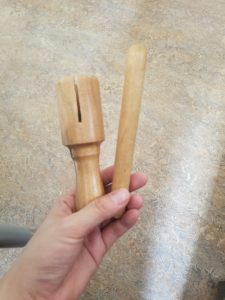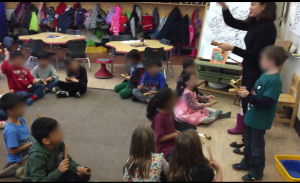Throughout the second week of two-week practicum, my grade one students had many opportunities to explore different ways to express themselves. It was a great week for them to show off their creativity skills through many disciplines such as in art, writing, music, literacy, dance and more.
On Thursday, I had a chance to teach music class where I taught how to create different rhythms and beats by using wooden percussion instrument. I used to volunteer in teaching music lessons in one of the kindergarten class during my undergraduate years and therefore, it was a great chance for me to apply my previous teaching experience to my practicum class. When I was teaching, I tried to connect our music lesson to IB curriculum in many ways such as by asking attitudes and attributes that students need to consider when playing the instrument during class and connecting to the current U.O.I. by mentioning how playing musical instrument is one of the ways to express yourself.
However, one of the most essential IB curriculum that I believe I taught during this class is going over some of the key concepts. Before I started handing out the instruments to the students, I asked them “what is it like?” and “what it is made out of?” in order to go over the key concept of ‘form’.

This is the instrument that I used during class. The instrument is called “Wooden Crow Sounder Tube”; when we hit the instrument with the given wooden stick, it makes a similar sound of a crow.
Also, I asked the class “how does it work to make a sound?” which is the main question that is addressed by the key concept of ‘function’. I was surprised by how the students were able to come up with so many different ways to make sound using this instrument. Some answers were very innovative and interesting that I have never thought of. For example, one of the students answered that we could put the wooden stick inside the hole in the middle of the wooden tube and shake it to make a sound. Also, when we started playing the instrument, one of the other students mentioned that instead of just hitting the tube part to make the same sound, we can try making different sound by striking the handle part of this wooden instrument. Interestingly when we tried this, the sound made the higher pitch and that’s when I introduced to the class the musical concept of ‘pitch’.

This is a picture of me teaching how to play a wooden crow sounder tube to the class.
I was just so amazed by the students’ curiosity and creativity during this class. I was amazed how they can easily come up with very innovative ideas and thoughts that no one would have thought of. On the other hand, I also learned how these IB key concepts provide students many opportunities to strengthen their thinking skills and able to share their own new ideas with the others. In addition, I was happy to see that some examples of inquiry-based learning were happening during my music class.
DH, this is risk-taking at its finest! Good for you for tackling a primary music class! I really like how you incorporated the key concepts of form and function – what a natural application of this Essential IB Element, as you mentioned. Giving children time to freely explore the instruments and figure out how to make sounds with them is important learning time. I wonder what you did afterwards? Did you expect that they play it correctly or is there a “correct” way? Some of the best memories I have are my two years as a K-3 music teacher. I think it strengthened my classroom management and the emphasized the significance to letting children fully experience learning in multi-modal ways. During the long practicum, you will have opportunities to build music into your daily routine. Singing, guitar playing – can you imagine the positive impact this will have on your diverse group? Wow!